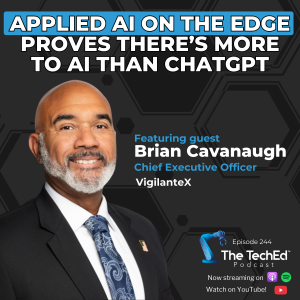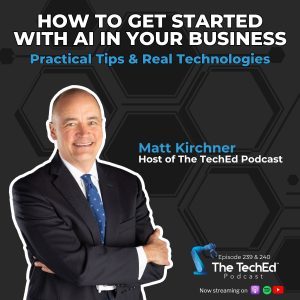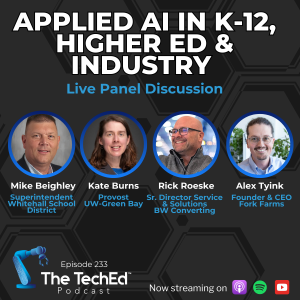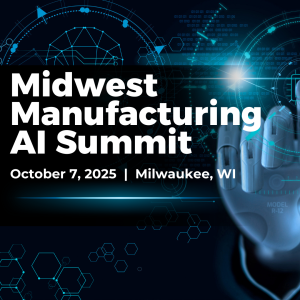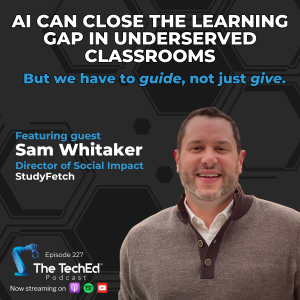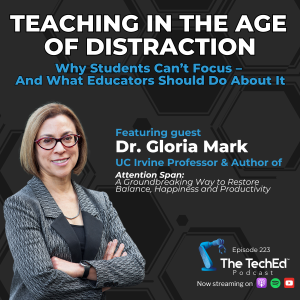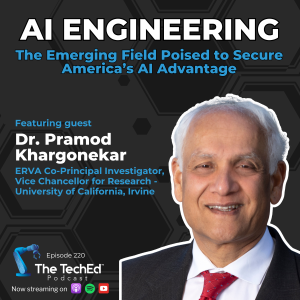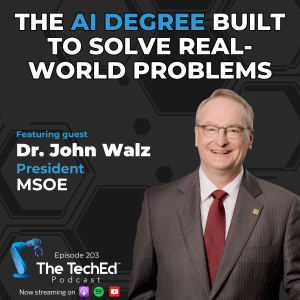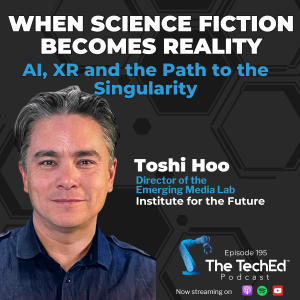5 Common AI Mistakes Made in Education
Artificial intelligence is changing our entire world, and that includes the classroom.
Some are quick adopters while others are banning the technology in class. Most are trying to figure out AI’s place in the classroom – how to embrace it in an ethical, safe way that enhances the student experience and improves learning outcomes.
But there are some things that education is getting totally wrong about artificial intelligence. In fact, Matt Kirchner lays out the 5 most common AI misconceptions in an episode of the TechEd Podcast:
Misconception 1: AI is Only for Computer Science
One of the biggest misconceptions is that AI learning should be confined to computer science classes. Of course, it belongs in computer science, but its applications extend far beyond, into all subjects and disciplines. For instance, AI can be used in language arts to analyze literary texts, in history to predict historical trends, and in biology to model ecological systems. Think of AI as another tool to achieve the learning outcomes of education in general and each subject in particular.
Education is meant to give students the knowledge and skills for their future. And since every industry is using AI in day-to-day work, students must know how to use it. In healthcare, AI is used for diagnostic imaging and personalized treatment plans. In finance, AI models predict market trends and detect fraud. In agriculture, AI optimizes crop yields and monitors soil health. One company – CADDi – is using AI to digitize and make a searchable catalog of a hundred years of hand-rendered manufacturing drawings. Ren is using AI to “systematize luck” in networking and relationships. By exposing students to AI’s diverse applications, we can prepare them for a wide range of careers.
AI’s integration into different subjects also encourages critical thinking and problem-solving. When students see how AI can be applied in multiple contexts, they begin to understand its potential and limitations. For example, using AI to predict historical trends can teach students about the importance of data quality and the impact of biases in data. Similarly, using AI in ecological modeling can highlight the complexities of natural systems and the need for interdisciplinary approaches to solve environmental problems.
Misconception 2: AI = ChatGPT
We’ve heard people use the terms artificial intelligence and ChatGPT synonymously. Sure, ChatGPT is probably the most popular generative AI tool on the market, but it’s just one tool in a sea of AI technologies. More broadly put, AI technologies include machine learning, neural networks, computer vision, and natural language processing. These technologies power innovations such as autonomous vehicles, predictive analytics, and smart manufacturing. Educators should teach students about the diverse AI landscape, demonstrating how different AI systems function and their practical applications in various fields.
For instance, computer vision is used in facial recognition systems, medical image analysis, and autonomous vehicles. Machine learning algorithms are applied in recommendation systems, financial forecasting, and natural language processing tasks such as sentiment analysis. Certainly there are AI tools built just for the classroom, which teachers should take advantage of. But also make sure to incorporate AI tools being used in the workforce so students have exposure and experience with those platforms.
Misconception 3: AI Should Be Kept Out of the Classroom
Some educators believe that AI should be banned from the classroom due to concerns about cheating and over-reliance on technology. We don’t disagree with the risks involved, especially during these early months and years of understanding how it will impact the learning process.
But banning AI is not the solution. Instead, we argue that, when used properly, AI can enhance learning outcomes. It can personalize learning experiences, helping students grasp complex concepts at their own pace. It makes learning less about rote memorization and more about the application of information learned in class.
Moreover, integrating AI into the classroom can foster creativity and critical thinking. Students can use AI tools to explore new ways of solving problems, conduct experiments, and create projects that would be difficult to achieve without technological assistance. For example, students can use AI to analyze large datasets, create simulations, and develop predictive models. These activities not only enhance their understanding of AI but also prepare them for future challenges where technology will play a crucial role.
Misconception 4: Ignoring the Risks of AI
We’re all for the adoption of AI, but not without considering the risks. There are data privacy issues, bias in algorithms, and the potential for reduced human interaction. School administration and executive leadership must decide on the guidelines for using AI, then make sure their teachers are properly trained on the risks and benefits of AI in the classroom. In turn, teachers must educate their students about ethical and transparent use of AI.
Students need to understand what data should and should not be shared with these tools. They should understand how to analyze and fact-check the responses they get from AI. They should be able to identify potential biases in answers. In other words, AI should never be the sole source for the answer, but an aid to help the student understand, analyze or create something new.
Misconception 5: We Should Fear AI
AI is here, and it’s here to stay. Being afraid of it (which may amount to banning it from the classroom) isn’t beneficial. Instead, we should focus on understanding and leveraging AI’s potential. Educators don’t need to be AI experts to use AI tools effectively. Simple, user-friendly AI applications can significantly enhance teaching and learning. For example, AI-driven analytics can provide insights into student performance, helping educators tailor their instruction to meet individual needs.
Educators should approach AI with a mindset of curiosity and openness, exploring how these tools can be integrated into their classroom. Professional development programs can help teachers gain confidence in using AI, providing them with the skills and knowledge needed to incorporate these technologies into their classrooms.
Educators should also not be afraid of their students using AI. With the proper guidance, students will probably pick up on the technology faster than their teachers! Teachers should embrace this. The key is transparency: give your students the freedom to use AI (even require it), and they will be transparent about how they used it in their assignments. Ban AI, and they will probably still use it while hiding that from you. In a world that’s using AI in the workforce, education should, too.
Dr. Dwayne Wood of National University put it this way: “Think of it as you’re forming a team with AI. You are offsetting some of your weaknesses with some of its strengths, but it also has weaknesses that you offset as the human in the loop.”
